Quasi-Linear Convective Systems in Catalonia Detected Through Radar and Lightning Data
Abstract
1. Introduction
2. Materials and Methods
2.1. Area of Study
2.2. Data
2.3. Methodology
- Intensity: The structure had lightning and high reflectivity radar echoes over Catalonia.
- Duration: The structure lasted more than 3 h.
- Length: The larger axis reached 100 km of continuous reflectivity (exceeding 30 dBZ) for at least one hour.
- Linearity: The length of the convective region is at least three times longer than the width.
3. Results
4. Discussion
- Most of the systems developed over land but half dissipated over the Mediterranean Sea.
- The predominant direction was from west to east. However, an important percentage did not move in a straight path.
- Most of the cases (85 %) occurred between July and October, and the rest occurred in June and November.
- There were two different behaviours regarding the time of occurrence: according to the diurnal convective cycle (land systems) and nocturnal structures (mainly occurring over the sea).
- The length path moved between 125 and 425 km, while the duration ranged between 192 and 510 min. In consequence, the average speed was 45.4 km/h.
- The maximum reflectivity usually (70 %) took place in the first third of the life cycle while the maximum lightning activity occurred later, in most cases around half of the duration of the QLCS. Also, it is important to remark that lightning activity continued in practically the entire life cycle and for the whole set of cases.
5. Conclusions
- We have shown how it is possible to detect QLCSs with remote sensing (radar and lightning flashes), even in limited covered areas. The main drawback is that some structures are not completely followed, because these systems can last for many hours and cross long paths.
- The results are very similar to the results obtained for other regions, but in particular with the main European climatology.
- We can distinguish between two main behaviours: diurnal and nocturnal QLCSs.
- Land and sea play important roles in the development, evolution, and dissipation of QLCSs.
- Identification of lightning jumps and severe weather phenomena in QLCSs to compare to other convective modes and provide a forecast guide;
- Characterization of the environments where the QLCSs occur in Catalonia, both in the mesoscale and the synoptic environments, to improve the knowledge and capability of forecasting in real-time surveillance tasks;
- Detection of discriminant signatures, such as the Mesoscale Convective Vortex or the cold pool;
- Combination of the presented method with overshooting signature data observed using satellites.
Author Contributions
Funding
Data Availability Statement
Acknowledgments
Conflicts of Interest
Abbreviations
| MCS | Mesoscale Convective System |
| MCV | Mesoscale Convective Vortex |
| QLCS | Quasi-Linear Convective System |
| MCC | Mesoscale Convective Complex |
| TS | Trailing Stratiform line |
| LS | Leading Stratiform line |
| PS | Parallel Stratiform line |
| CG | cloud-to-ground |
| TL | Total Lightning |
| +CG | Positive Cloud-to-Ground |
| −CG | Negative Cloud-to-Ground |
| CT | Cloud Top |
| FR | Flash Rate |
| IR | infra-red |
| BT | Brightness Temperature |
| XRAD | Xarxa de Radars (Radar Network) |
| XDDE | Xarxa de Detectors de Descàrregues Elèctriques (Lightning Location Detection System) |
| VHF | Very high frequency |
| LF | Low frequency |
| IC | Intra-cloud |
| PPI | Plan Position Indicator |
| CAPPI | Constant Altitude Plan Position Indicator |
References
- Houze, R.A., Jr. Mesoscale convective systems. Rev. Geophys. 2004, 42, RG4003. [Google Scholar] [CrossRef]
- Houze, R.A., Jr. Mesoscale convective systems. Int. Geophys. 2014, 104, 237–286. [Google Scholar]
- Schumacher, R.S.; Rasmussen, K.L. The formation, character and changing nature of mesoscale convective systems. Nat. Rev. Earth Environ. 2020, 1, 300–314. [Google Scholar] [CrossRef]
- Hitchcock, S.M.; Lane, T.P. Two Quasi-Linear Convective Systems, Their Mesoscale Structure and Moisture Sources. Mon. Weather Rev. 2023, 151, 663–688. [Google Scholar] [CrossRef]
- Schumacher, R.S. Mechanisms for quasi-stationary behavior in simulated heavy-rain-producing convective systems. J. Atmos. Sci. 2009, 66, 1543–1568. [Google Scholar] [CrossRef]
- Ashley, W.S.; Haberlie, A.M.; Strohm, J. A climatology of quasi-linear convective systems and their hazards in the United States. Weather Forecast 2019, 34, 1605–1631. [Google Scholar] [CrossRef]
- Haberlie, A.M.; Ashley, W.S.; Karpinski, M.R. Mean storms: Composites of radar reflectivity images during two decades of severe thunderstorm events. Int. J. Climatol. 2021, 41, E1738–E1756. [Google Scholar] [CrossRef]
- Lovell, L.T.; Parker, M.D. Simulated QLCS vortices in a high-shear, low-CAPE environment. Weather Forecast 2022, 37, 989–1012. [Google Scholar] [CrossRef]
- Lyza, A.W.; Clayton, A.W.; Knupp, K.R.; Lenning, E.; Friedlein, M.T.; Castro, R.L.; Bentley, E.S. Analysis of Mesovortex Characteristics, Behavior, and Interactions during the Second 30 June-1 July 2014 Midwestern Derecho Event. E-J. Sev. Storms Meteorol. 2017, 12, 1–33. [Google Scholar] [CrossRef]
- Marion, G.R.; Trapp, R.J. Controls of quasi-linear convective system tornado intensity. J. Atmos. Sci. 2021, 78, 1189–1205. [Google Scholar] [CrossRef]
- Brown, M.C.; Marion, G.R.; Coniglio, M.C. Influence of Low-Level Shear Orientation and Magnitude on the Evolution and Rotation of Idealized Squall Lines. Part I: Storm Morphology and Bulk Updraft/Mesovortex Attributes. Mon. Weather Rev. 2024, 152, 2089–2110. [Google Scholar] [CrossRef]
- Gibbs, J.G. Evaluating Precursor Signals for QLCS Tornado and Higher Impact Straight-Line Wind Events. J. Oper. Meteorol. 2021, 9, 62–75. [Google Scholar] [CrossRef]
- McDonald, J.M.; Weiss, C.C. Cold pool characteristics of tornadic quasi-linear convective systems and other convective modes observed during VORTEX-SE. Mon. Weather Rev. 2021, 149, 821–840. [Google Scholar] [CrossRef]
- Murphy, T.A.; Stetzer, T.M.; Walker, L.; Fricker, T.; Bryant, B.; Woodrum, C. Analysis of the 12 April 2020 Northern Louisiana Tornadic QLCS. J. Oper. Meteorol. 2022, 10, 43–62. [Google Scholar] [CrossRef]
- Parker, M.D.; Johnson, R.H. Organizational modes of midlatitude mesoscale convective systems. Mon. Weather Rev. 2000, 128, 3413–3436. [Google Scholar]
- Correoso, J.F.; Hernández, E.; García-Herrera, R.; Barriopedro, D.; Paredes, D. A 3-year study of cloud-to-ground lightning flash characteristics of Mesoscale convective systems over the Western Mediterranean Sea. Atmos. Res. 2006, 79, 89–107. [Google Scholar]
- Carey, L.D.; Murphy, M.J.; McCormick, T.L.; Demetriades, N.W. Lightning location relative to storm structure in a leading-line, trailing-stratiform mesoscale convective system. J. Geophys. Res. Atmos. 2005, 110, D03105. [Google Scholar]
- Ringhausen, J.; Chmielewski, V.; Calhoun, K. Inter-Comparison of Lightning Measurements in Quasi-Linear Convective Systems. Atmosphere 2024, 15, 309. [Google Scholar] [CrossRef]
- Parker, M.D.; Rutledge, S.A.; Johnson, R.H. Cloud-to-ground lightning in linear mesoscale convective systems. Mon. Weather Rev. 2001, 129, 1232–1242. [Google Scholar]
- Wang, F.; Liu, H.; Dong, W.; Zhang, Y.; Yao, W.; Zheng, D. Radar reflectivity of lightning flashes in stratiform regions of mesoscale convective systems. J. Geophys. Res. Atmos. 2019, 124, 14114–14132. [Google Scholar] [CrossRef]
- Goodnight, J.S.; Chehak, D.A.; Trapp, R.J. Quantification of QLCS tornadogenesis, associated characteristics, and environments across a large sample. Weather Forecast 2022, 37, 2087–2105. [Google Scholar] [CrossRef]
- Conrad, D.M.; Knupp, K.R. Doppler radar observations of horizontal shearing instability in quasi-linear convective systems. Mon. Weather Rev. 2019, 147, 1297–1318. [Google Scholar] [CrossRef]
- Thompson, R.L.; Smith, B.T.; Grams, J.S.; Dean, A.R.; Broyles, C. Convective modes for significant severe thunderstorms in the contiguous United States. Part II: Supercell and QLCS tornado environments. Weather Forecast 2012, 27, 1136–1154. [Google Scholar] [CrossRef]
- Surowiecki, A.; Pilguj, N.; Taszarek, M.; Piasecki, K.; Púčik, T.; Brooks, H.E. Quasi-linear convective systems and derechoes across Europe: Climatology, accompanying hazards and societal impacts. Bull. Am. Meteorol. Soc. 2024, 105, E1619–E1643. [Google Scholar] [CrossRef]
- Schumacher, R.S.; Johnson, R.H. Organization and environmental properties of extreme-rain-producing mesoscale convective systems. Mon. Weather Rev. 2005, 133, 961–976. [Google Scholar] [CrossRef]
- Parker, M.D.; Johnson, R.H. Structures and dynamics of quasi-2D mesoscale convective systems. J. Atmos. Sci. 2004, 61, 545–567. [Google Scholar] [CrossRef]
- Wang, F.; Zhang, Y.; Liu, H.; Yao, W.; Meng, Q. Characteristics of cloud-to-ground lightning strikes in the stratiform regions of mesoscale convective systems. Atmos. Res. 2016, 178, 207–216. [Google Scholar] [CrossRef]
- Surowiecki, A.; Taszarek, M. A 10-year radar-based climatology of mesoscale convective system archetypes and derechos in Poland. Mon. Weather Rev. 2020, 148, 3471–3488. [Google Scholar] [CrossRef]
- Bech, J.; Arús, J.; Castán, S.; Pineda, N.; Rigo, T.; Montanyà, J.; van der Velde, O. A study of the 21 March 2012 tornadic quasi linear convective system in Catalonia. Atmos. Res. 2015, 158, 192–209. [Google Scholar] [CrossRef]
- López, J.M. A Mediterranean derecho: Catalonia (Spain), 17th August 2003. Atmos. Res. 2007, 83, 272–283. [Google Scholar] [CrossRef]
- Ramis, C.; Llasat, M.C.; Genovés, A.; Jansà, A. The October-1987 floods in Catalonia: Synoptic and mesoscale mechanisms. Meteorol. Appl. 1994, 1, 337–350. [Google Scholar] [CrossRef]
- Romero, R.; Ramis, C.; Homar, V. On the severe convective storm of 29 October 2013 in the Balearic Islands: Observational and numerical study. Q. J. R. Meteorol. Soc. 2015, 141, 1208–1222. [Google Scholar] [CrossRef]
- Rigo, T.; Llasat, M. Radar analysis of the life cycle of Mesoscale Convective Systems during the 10 June 2000 event. Nat. Hazards Earth Syst. Sci. 2005, 5, 959–970. [Google Scholar] [CrossRef]
- Rigo, T.; Llasat, M. A methodology for the classification of convective structures using meteorological radar: Application to heavy rainfall events on the Mediterranean coast of the Iberian Peninsula. Nat. Hazards Earth Syst. Sci. 2004, 4, 59–68. [Google Scholar] [CrossRef]
- Rigo, T.; Llasat, M.C. Analysis of mesoscale convective systems in Catalonia using meteorological radar for the period 1996–2000. Atmos. Res. 2007, 83, 458–472. [Google Scholar] [CrossRef]
- Rigo, T.; Berenguer, M.; del Carmen Llasat, M. An improved analysis of mesoscale convective systems in the western Mediterranean using weather radar. Atmos. Res. 2019, 227, 147–156. [Google Scholar] [CrossRef]
- Bech, J.; Pineda, N.; Rigo, T.; Aran, M. Remote sensing analysis of a Mediterranean thundersnow and low-altitude heavy snowfall event. Atmos. Res. 2013, 123, 305–322. [Google Scholar] [CrossRef]
- Farnell, C.; Rigo, T.; Pineda, N. Lightning jump as a nowcast predictor: Application to severe weather events in Catalonia. Atmos. Res. 2017, 183, 130–141. [Google Scholar] [CrossRef]
- Llasat, M.C.; Marcos, R.; Turco, M.; Gilabert, J.; Llasat-Botija, M. Trends in flash flood events versus convective precipitation in the Mediterranean region: The case of Catalonia. J. Hydrol. 2016, 541, 24–37. [Google Scholar] [CrossRef]
- van der Velde, O.A.; Montanyà, J.; Soula, S.; Pineda, N.; Mlynarczyk, J. Bidirectional leader development in sprite-producing positive cloud-to-ground flashes: Origins and characteristics of positive and negative leaders. J. Geophys. Res. Atmos. 2014, 119, 12–755. [Google Scholar] [CrossRef]
- Rigo, T.; Castillo, S. Evolution of Radar and Lightning Variables in Convective Events in Barcelona and Surroundings for the Period 2006–2020. Adv. Environ. Eng. Res. 2021, 2, 1–18. [Google Scholar] [CrossRef]
- R Core Team. R: A Language and Environment for Statistical Computing; R Foundation for Statistical Computing: Vienna, Austria, 2022. [Google Scholar]
- Hijmans, R.J. raster: Geographic Data Analysis and Modeling; R Package Version 3.6-3; R Foundation for Statistical Computing: Vienna, Austria, 2022. [Google Scholar]
- Bivand, R.; Keitt, T.; Rowlingson, B. rgdal: Bindings for the ‘Geospatial’ Data Abstraction Library. R Package Version 1.6-2; R Foundation for Statistical Computing: Vienna, Austria, 2022. [Google Scholar]
- Ligges, U.; Mächler, M. Scatterplot3d—An R Package for Visualizing Multivariate Data. J. Stat. Softw. 2003, 8, 1–20. [Google Scholar] [CrossRef]
- Jackson, A.L.; Parnell, A.C.; Inger, R.; Bearhop, S. Comparing isotopic niche widths among and within communities: SIBER—Stable Isotope Bayesian Ellipses in R. J. Anim. Ecol. 2011, 595–602. [Google Scholar] [CrossRef]
- Gama, J.; Chernov, N. conicfit: Algorithms for Fitting Circles, Ellipses and Conics Based on the Work by Prof. Nikolai Chernov; R Package Version 1.0.4; R Foundation for Statistical Computing: Vienna, Austria, 2015. [Google Scholar]
- Trapero, L.; Bech, J.; Rigo, T.; Pineda, N.; Forcadell, D. Uncertainty of precipitation estimates in convective events by the Meteorological Service of Catalonia radar network. Atmos. Res. 2009, 93, 408–418. [Google Scholar] [CrossRef]
- Montanyà, J.; Pineda, N.; March, V.; Illa, A.; Romero, D.; Solà, G. Experimental evaluation of the Catalan lightning detection network. In Proceedings of the 19th International Lightning Detection Conference, Tucson, AZ, USA, 24–25 April 2006. [Google Scholar]
- del Moral, A.; del Carmen Llasat, M.; Rigo, T. Connecting flash flood events with radar-derived convective storm characteristics on the northwestern Mediterranean coast: Knowing the present for better future scenarios adaptation. Atmos. Res. 2020, 238, 104863. [Google Scholar] [CrossRef]
- Doswell, C.A., III. Severe convective storms—An overview. In Severe Convective Storms; American Meteorological Society: Boston, MA, USA, 2001; pp. 1–26. [Google Scholar]


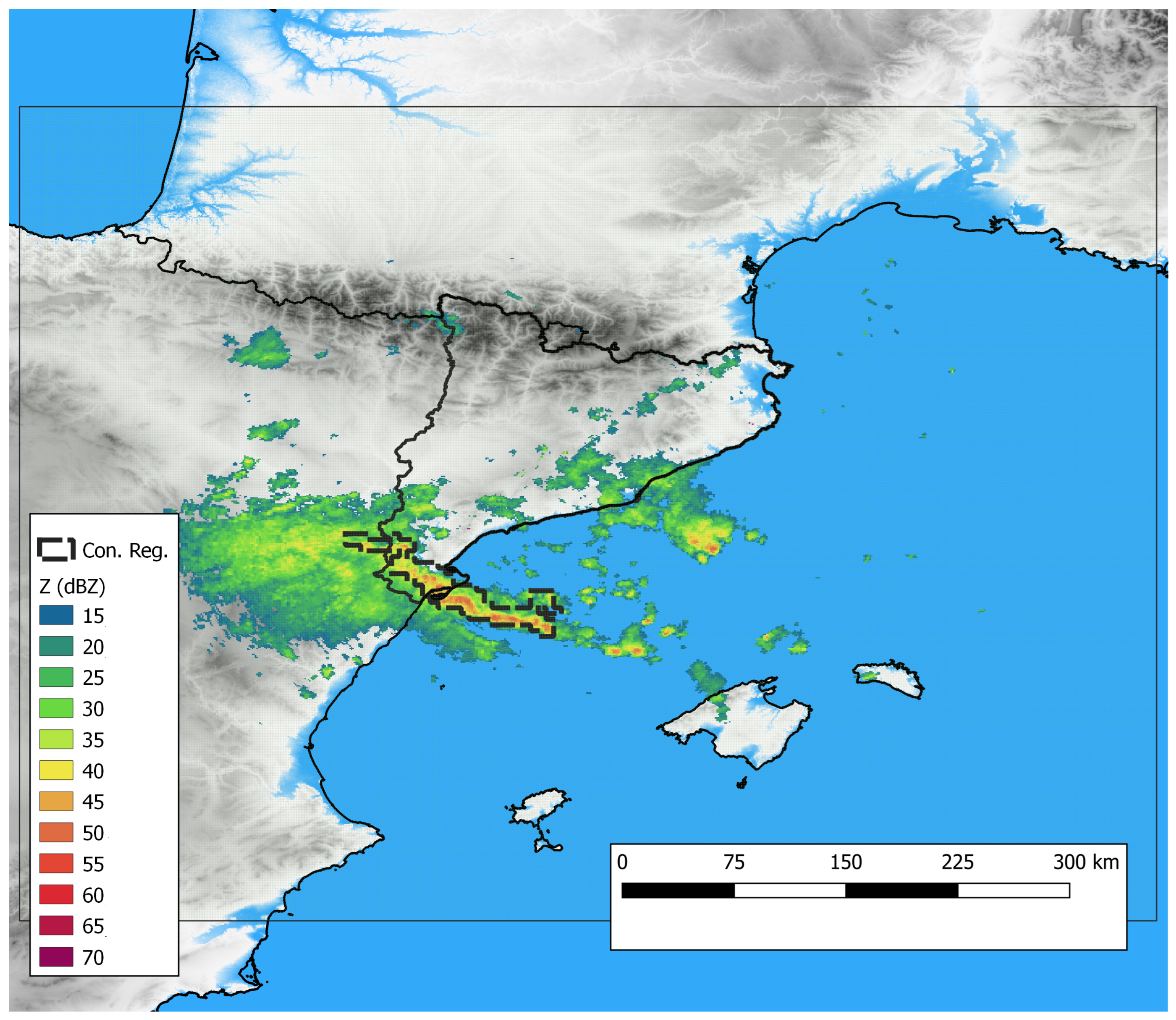


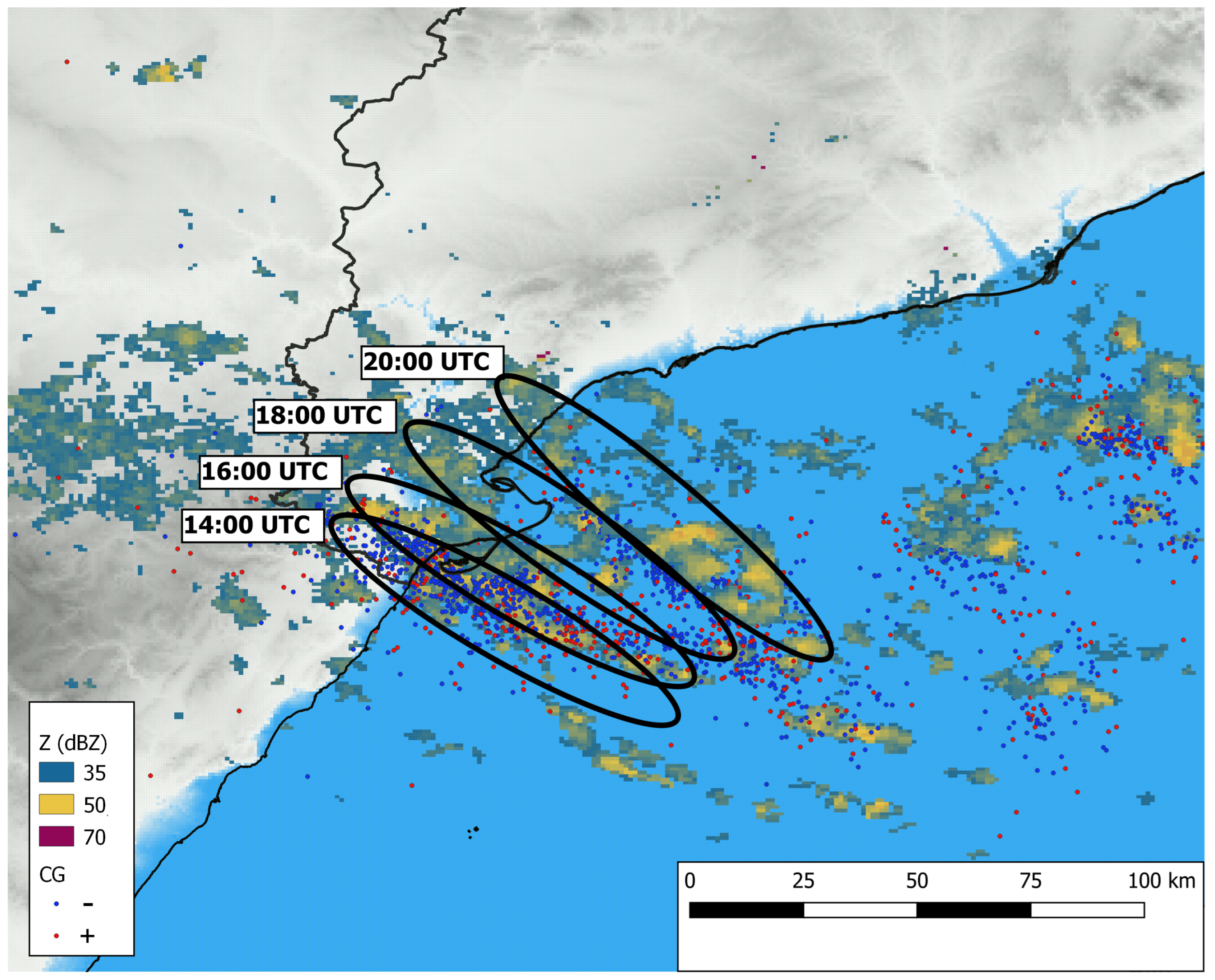
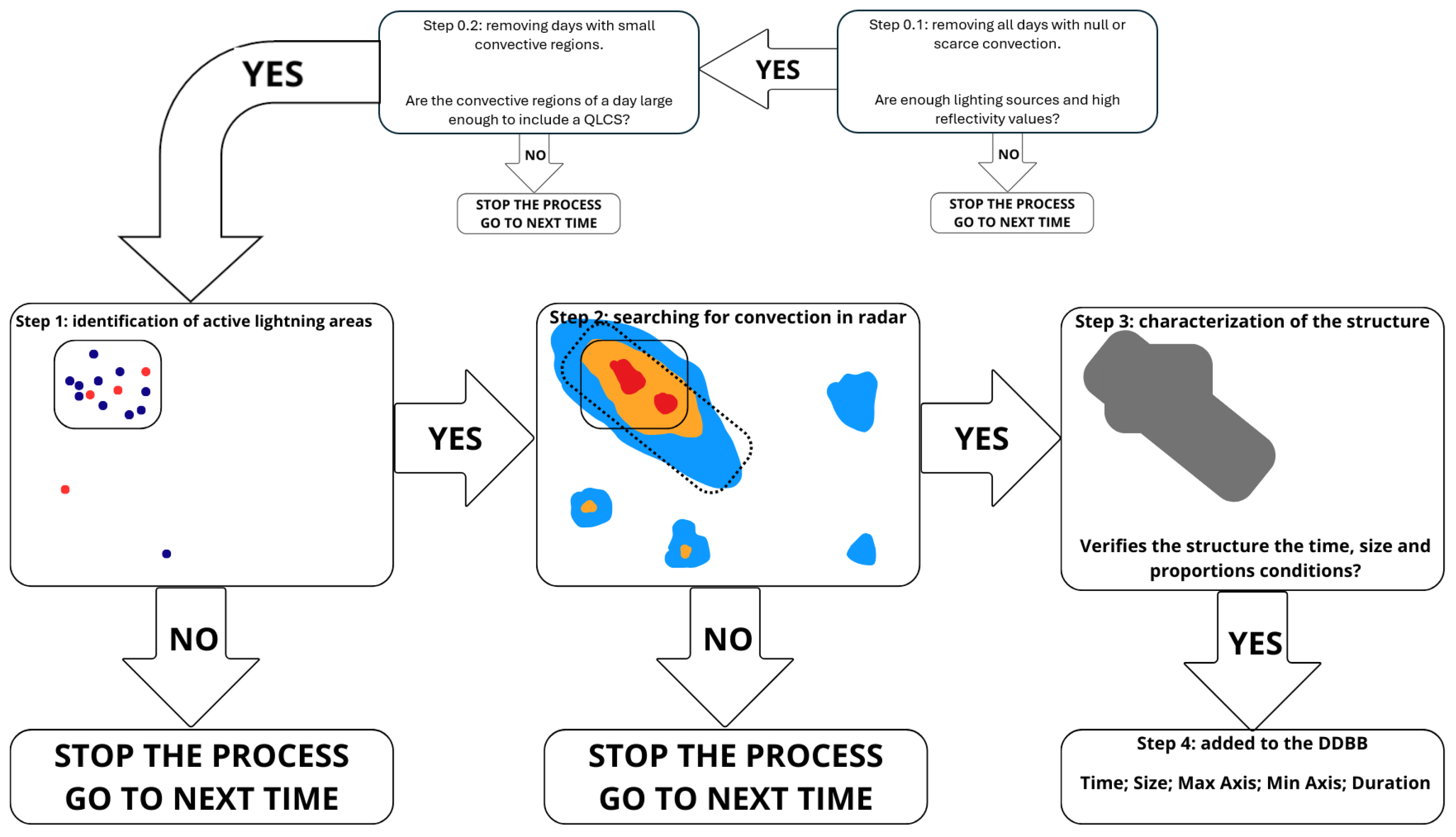

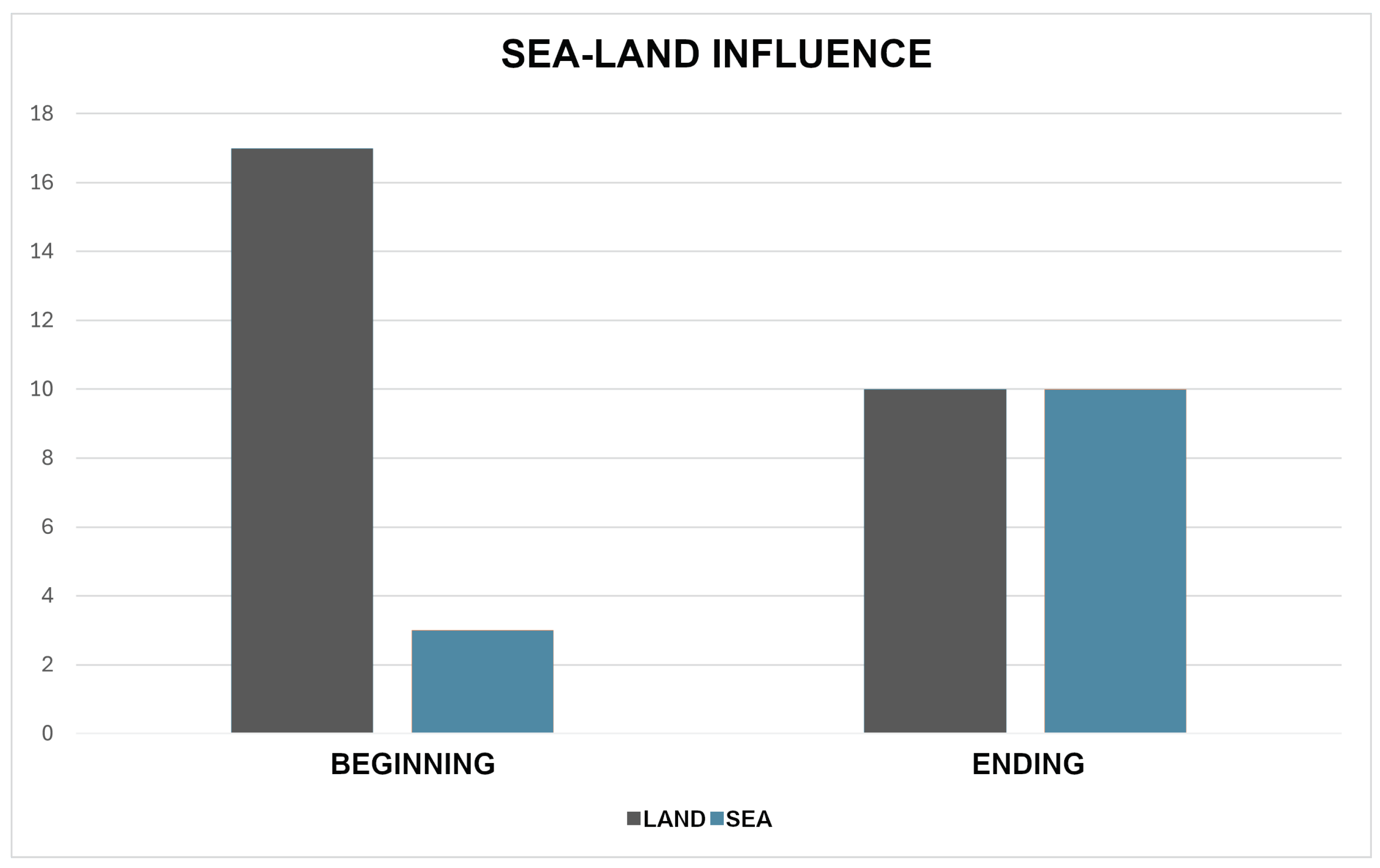
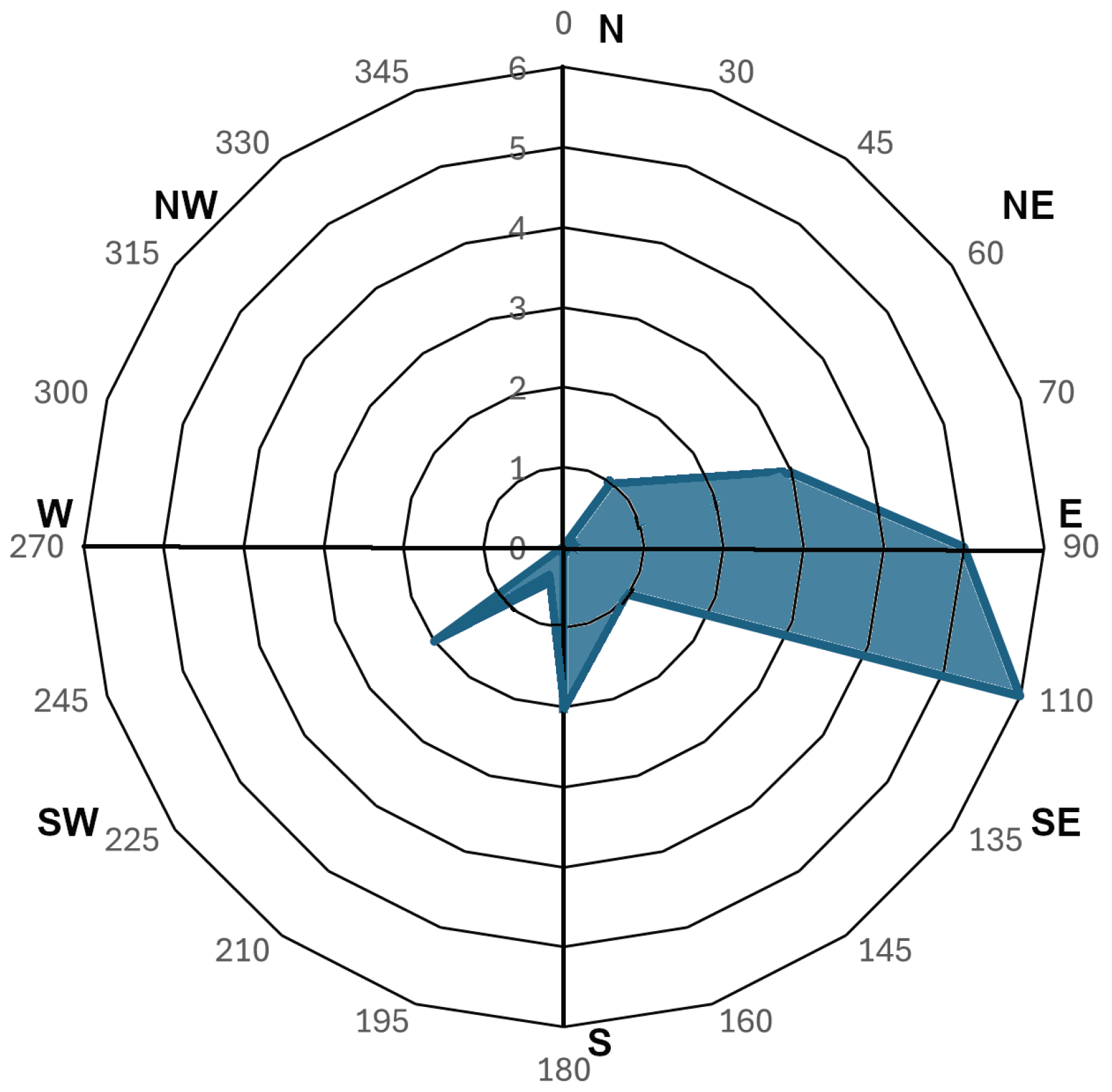
| Date (Day Month Year) | Duration (min) | Path Length (km) |
|---|---|---|
| 4 October 2013 | 376 | 360 |
| 7 July 2014 | 205 | 384 |
| 31 July 2015 | 341 | 456 |
| 17 August 2015 | 237 | 354 |
| 3 September 2015 | 229 | 336 |
| 22 July 2016 | 127 | 252 |
| 6 October 2016 | 273 | 312 |
| 23 November 2016 | 206 | 336 |
| 18 October 2017 | 182 | 336 |
| 9 August 2018 | 195 | 228 |
| 6 September 2018 | 200 | 192 |
| 19 October 2018 | 210 | 216 |
| 10 September 2019 | 207 | 288 |
| 22 October 2019 | 347 | 372 |
| 5 August 2022 | 204 | 360 |
| 31 August 2022 | 305 | 324 |
| 23 September 2022 | 422 | 510 |
| 29 June 2023 | 358 | 468 |
| 29 June 2023 | 223 | 432 |
| 27 July 2023 | 292 | 372 |
| Zmx (dBZ) | Zmn (dBZ) | InsZmx (%) | Length (km) | Duration (min) | Speed (km/h) | DOY | TimeIni | TimeEnd | Month | |
|---|---|---|---|---|---|---|---|---|---|---|
| MAX | 57.0 | 53.6 | 86.7 | 422.4 | 510.0 | 62.7 | 327.0 | 19.0 | 23.0 | 11.0 |
| MEAN | 53.6 | 49.9 | 28.1 | 256.8 | 344.4 | 45.4 | 242.0 | 10.2 | 14.8 | 8.5 |
| TLmx | TLmn | InsTLmx (%) | CG+mx | CG+mn | InsCG+mx (%) | CG−mx | CG−mn | InsCG−mx (%) | (%) | |
| MAX | 666.0 | 361.5 | 86.9 | 452.0 | 201.1 | 100.0 | 487.0 | 160.4 | 100.0 | 100.0 |
| MEAN | 262.1 | 137.0 | 51.1 | 124.9 | 55.9 | 58.6 | 177.8 | 81.1 | 50.8 | 97.5 |
Disclaimer/Publisher’s Note: The statements, opinions and data contained in all publications are solely those of the individual author(s) and contributor(s) and not of MDPI and/or the editor(s). MDPI and/or the editor(s) disclaim responsibility for any injury to people or property resulting from any ideas, methods, instructions or products referred to in the content. |
© 2024 by the authors. Licensee MDPI, Basel, Switzerland. This article is an open access article distributed under the terms and conditions of the Creative Commons Attribution (CC BY) license (https://creativecommons.org/licenses/by/4.0/).
Share and Cite
Rigo, T.; Farnell, C. Quasi-Linear Convective Systems in Catalonia Detected Through Radar and Lightning Data. Remote Sens. 2024, 16, 4262. https://doi.org/10.3390/rs16224262
Rigo T, Farnell C. Quasi-Linear Convective Systems in Catalonia Detected Through Radar and Lightning Data. Remote Sensing. 2024; 16(22):4262. https://doi.org/10.3390/rs16224262
Chicago/Turabian StyleRigo, Tomeu, and Carme Farnell. 2024. "Quasi-Linear Convective Systems in Catalonia Detected Through Radar and Lightning Data" Remote Sensing 16, no. 22: 4262. https://doi.org/10.3390/rs16224262
APA StyleRigo, T., & Farnell, C. (2024). Quasi-Linear Convective Systems in Catalonia Detected Through Radar and Lightning Data. Remote Sensing, 16(22), 4262. https://doi.org/10.3390/rs16224262






